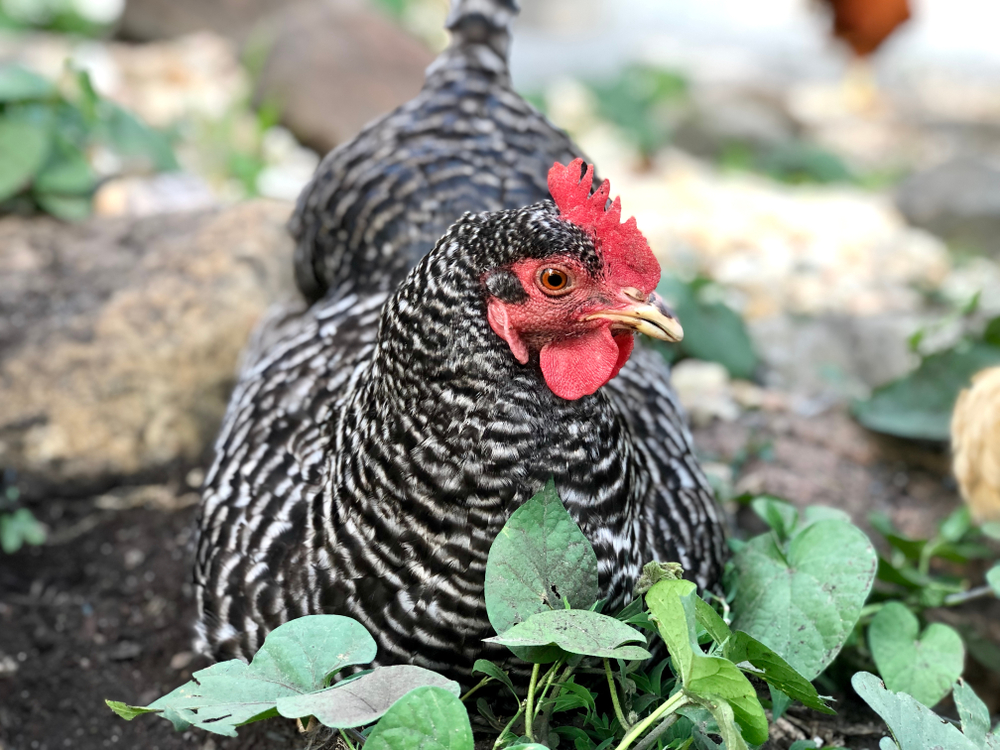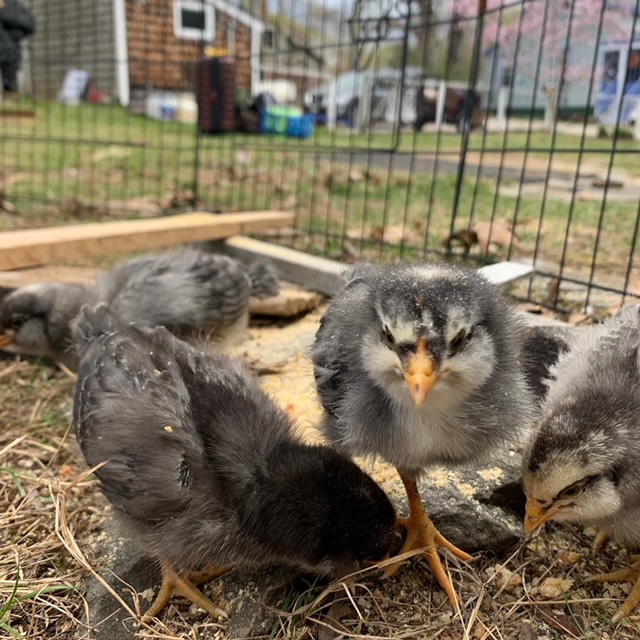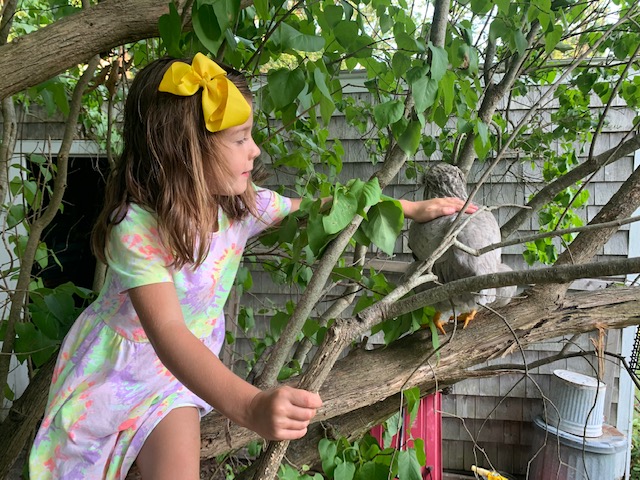Our family’s backyard chickens, acquired in the early days of the pandemic, have shown me how to slow down and rethink my moral principles.

It began with a peep. Below me, warming under the tangerine glow of a metal heat lamp, were five wobbling chicks: Sasha, Comet, McLovin’, Chubbs and John Cena. Their high-pitched peeps sounded like audial confetti; their coats, yellow and fuzzy, like a child’s drawing of the sun. The most recent addition to my family of eight, these chickens were one-third Barred Rock, two-thirds Easter Egger and 100-percent ours, given to us by our neighbor Molly. “Go ahead and scoop ‘em up,” she told us. “They’re yours now.”
My neighbor Molly had midwifed the chickens since they were eggs. My kids and I had been visiting Molly at least once a week throughout the pandemic, riding our bikes up the gravel road to her little backyard farm to learn about animal husbandry. She raised ducks and chickens, rescued neglected pet rabbits and baby orphaned mice, and she recently acquired two black-fleeced sheep, one nameless, the other she called Julian. Like my children, Molly was pandemic-homeschooled, but my kids were five and eight; Molly was going on eighteen, self-sufficient, self-taught and self-led, qualities I hoped she’d transmit to my kids through osmosis.
Sometimes, the kids and I would clean out Herb the Silkie chicken’s coop or feed frozen peas to the Muscovy ducks. We helped dump soiled hay into the compost, picked blueberries, searched the yard for shedded snake skin. At the end of each visit, we’d all reconvene in a circle on Molly’s front lawn, picking at the crabgrass or stroking one of the lop-eared bunnies, hardly speaking. It felt faintly decadent—to rest and just be, to take in the sun, the fresh air and the sweetness of the animals when the rest of the world was at loose ends, but that’s what being around those beasts did: It made us feel good, made us feel at peace. This was the first summer of the COVID-19 pandemic, late July 2020, and not long after that we adopted our first animal from Molly: Raspberry Jam, a baby mini-Rex rabbit. Not long after the rabbit, we expanded our brood once more.
Peep, peep. They were our first chickens. These animals were not lawn ornaments or a temporary fad we’d rid ourselves of on Craigslist when their novelty wore off. The chickens were part of a plan I’d hatched months ago, and in acquiring them, the plan was finally set in motion.

Photo by Mira Ptacin.
Let me explain: I live on a small island in Maine, the mainland only accessible by ferry with limited runs. After the first pandemic shutdown, simmering indoors during the winter months, I realized that not only should I be prepared with extra food, water and toiletries at all times, which I wasn’t, but that it was time I learned to be more self-sufficient. I began researching and interviewing survivalist communities; I studied backyard homesteading books. I put together my own end-of-days food supplies and stockpile and began planning with my neighbors a community victory garden. I was actively redefining what the idea of home meant to me, what my home was going to represent and, once I had my first set of livestock, things would really be set in motion. Or so I thought.
Until we had birds of our own, the most exposure I had to hens was benign, limited and one-dimensional: Barnyard chickens were just the illustrations in my childhood board books, they were McNuggets or they were something to hatch as a science class experiment, Lord only knew where the chicks ultimately ended up (McNuggets, perhaps?). In my twenties, I became a vegetarian after reading Jonathan Safran Foer’s Eating Animals, but I still ate eggs, as long as their labels (falsely) reassured me they came from “free-range” chickens.

The author’s son carries part of the flock. Photo by Mira Ptacin.
In the state of Maine, it’s nearly impossible to go for a drive and not pass old mega-chicken coops, cavernous tin barns that once housed thousands of egg layers and broilers. Each time I drive past these old relics, I shiver at the thought of what went on beneath the tin roofs. However, the egg-laying industry has not changed all that much. Rather, it has exploded: The United States produces more than 96 billion eggs each year, using up to 325 million (exhausted) egg-laying hens, many of which spend their lives scrunched in painful mesh wire cages stacked. Presently, only 186 companies account for 99 percent of the egg industry and with little regulation.
A study published in Poultry Science last year explains that “high production hens’ structural bone is mobilized throughout the laying period in order to contribute to the formation of eggshell” and the majority of these hens suffer significant osteoporosis. A healthy chicken can live up to 10 years, but for these hens, when egg production begins to wane, which happens around age two, they are rendered useless and are sent to the slaughterhouse—according to PETA, more than 100 million a year. Inside these warehouses, millions of days-old male chicks, useless to the egg-laying industry, are culled, tossed away like garbage, thrown in a high-speed grinder called a “macerator.”
[RELATED: Germany Becomes First Country to Ban Mass Culling of Male Chicks]
You might think that the solution to ease their suffering is to buy “free-range” or “cage-free” eggs, but these are, in general, meaningless terms that remain vague and unregulated. The USDA’s definition of free range states that “producers must demonstrate to the Agency that the poultry has been allowed access to the outside.” Yet there are no requirements for how many birds are to have access, how much time the birds spend outdoors or how much outdoor space they can access. There might be a tiny slot at the end of the warehouse where a chicken would have to wade through a sea of other hens to get to, and this door might be open for only a few minutes each day, but the facility would still, by definition, be considered “free range.” The United Egg Producers only require “cage-free” farms to have 1 to 1.5 square feet per hen—hardly enough for a bird to be able to even spread her wings. Today in the United States, there are still no federal laws protecting the billions of factory farm animals that lead an entire life of suffering, only to eventually become food for Americans. On average, 97 chickens are killed every 0.05 seconds worldwide. It’s all pretty foul.
When our own chicks had grown into pullets, feathered and strong enough to be moved out of our home and into the yard, they were free range. Moving like an amoeba, the girls explored the outdoors, curiously pecking at our compost pile, meandering around our backyard, squatting under the peonies, their feathers sleek as an opera cloak. And as summer blended into fall, my objective for having egg-laying hens for practical purposes waned, as did my quest to become a prepper homesteader. In the mornings and in my pajamas, I’d release my hens from their coop, then go sit on top of the picnic table with my coffee and kids, watching the girls pick ticks out of the grass, chase away chipmunks, thin out my tomato garden. By just observing them, we began to see a world outside our human one. We came to learn their clucks and meanings. We noticed they had personalities (McLovin’ is tender and affectionate, while Comet is stubborn and rebellious) and that they breathe out of their mouths when they’re hot. Like dogs, they enjoy a Big Stretch. We observed that they take “dust baths”—the chicken equivalent of a shower—where the chickens dance furiously in dirt as if having a seizure, in which they’re actually digging trenches and caking themselves in dirt to clean their feathers, the soil absorbing excess moisture and oil.

The author’s daughter tends to a hen. Photo by Mira Ptacin.
One of the cutest things I’ve ever seen is John Cena hopping into the air as high as she could in an attempt to catch a mosquito. Every evening at dusk, the hens cluster around their coop like teenagers smoking, waiting for me to open the gate for them. After saying goodnight to each of them, I’d go to my own perch, and there, I’d read about chickens. Initially, it was a quick Google search after one of my children asked me a question about our flock that I couldn’t answer, but an hour or two later, I’d still be on my phone, having gone down a rabbit hole of chicken lit. Did you know that the origins of chickens can be traced back to the jungles of India? Or that chickens dream when they sleep? Or that the color of a chicken’s egg depends on its earlobe. Chickens are fascinating, loveable. They can recognize faces, are omnivores and they are not flightless (I’ve witnessed mine get airborne and perch into a tall oak tree in my yard). A writer friend of mine once reported on a male Wyandotte chicken who lived for 18 months after his head had been cut off.
In his lesser known essay, “The Hen: An Appreciation,” EB White warned, “Don’t try to convey your enthusiasm for chickens to anyone else” and yet, I can’t help but tell you that by my chickens, I am utterly absorbed. My flock is allergic to ideology, yet they have a conspicuous appetite for human connection. They are effusive and affectionate and have a prickly side. They’re feisty, curious and transparent in their ambitions: bugs. “A hen is an alarmist but she is not silly,” wrote White. They are also expert listeners and eloquent cluckers. I believe I first fell in love with my chickens when they began to perch in our lilac tree, the bush bursting into a purple bloom, the hens napping within it.
[RELATED: It’s a Great Time to Find a Local Egg Dealer]
It’s been several months now and our chickens still have not laid a single egg. They have, however, decimated the victory gardens I planted earlier in the summer. Back then, I thought that by now I would have mastered self-sufficiency and homesteading, built a solar grid, powered the entire island, built community gardens and led the country into an alternative home keeping brigade overnight. But instead, my son has become a vegetarian, we have great compost and I’ve grown exponentially. I owe this to my hens. Chickens have therapeutic effects. Because of their presence, I have learned a new rhythm. I have slowed down my tempo. With my prepper/homesteading plan, I thought we would start by changing our actions, but before that, I learned it had to start with stillness. When I thrusted myself into animal husbandry, I landed instead in animal appreciation; something I was going to eat has instead made me a meliorist.
There is a distorted belief that good for the other is somehow going to be bad for us, but it is effortless to have a generosity of compassion to all creatures, great and small. Our chickens are not here to serve a human need—in our family, they coexist as equals, browsing with the bumblebees, deserving love and food and shelter and freedom. I do not patronize my hens; to my hens, I remain devoted. And perhaps my home is not a homestead. Perhaps, it’s instead becoming more of a church, providing not just a feeling of safety, but a feeling of being unburdened. It is a meditation. An observing. Because if you put your focus on the sacred, grace will grow, and it will lift you up.
Mira Ptacin is the author of the books Poor Your Soul and The In-Betweens: The Spiritualists, Mediums, and Legends of Camp Etna. She teaches at the Maine College of Art and Design as well as the Maine Correctional Center. She lives on Peaks Island, Maine, with her animals and family.
Nice story! I appreciate your attitude toward your hens.
Your piece was one of the most beautiful words and enlightenment. I aspire to your ambitions and hope hope to come to the same conclusions. Just a wonderful read and spiritual warming. Thank you.
I enjoyed your story and observation that they were great pets and not egg laying chickens! (Kind of funny to find that out) But, lovey that you realized those chickens were going to be just pets! And they had their own personalities! What a lovely story!
Mira, what a wonderful essay, commitment and “devotional”! I love how you express your faith in these hens, in your home and garden, and your fun puns. My daughter’s 13 (one was a runaway from a neighbor who chose to stay with hers!) hens are in their second year, and she raised them from chick to chicken, from the guest bathtub to their henhouse, which her husband built to match their beautiful house! Lindsey’s “girls” all have their names and personalities and she has learned SO much from and about them. They didn’t lay until they were mature enough, and… Read more »
Learn about poultry feed formulation for healthy and profitable chicken farming.
Our 16 year old neighbor raises chickens. My favorite is the one that talks constantly. I believe she talks to herself. I toss fists of brown and brown and wild rice left over from a bag, oatmeal, and things like bell pepper seeds across the fence. Gertrude, the talker, rushes to the fence when she sees me or when she hears the back door opening—knowing I’ll have a treat. Their eggs are beauties of different shades of tan and white and a pale blue-green. They are delicious but small/medium. I want my own flock but am reminded of the toll… Read more »
I appreciate your concern for your chickens and the uniqueness of the personalities of all animals. For those considering backyard chickens for eggs, please check out a blog post I wrote:
https://www.vegavengers.com/post/why-backyard-eggs-aren-t-all-they-re-cracked-up-to-be